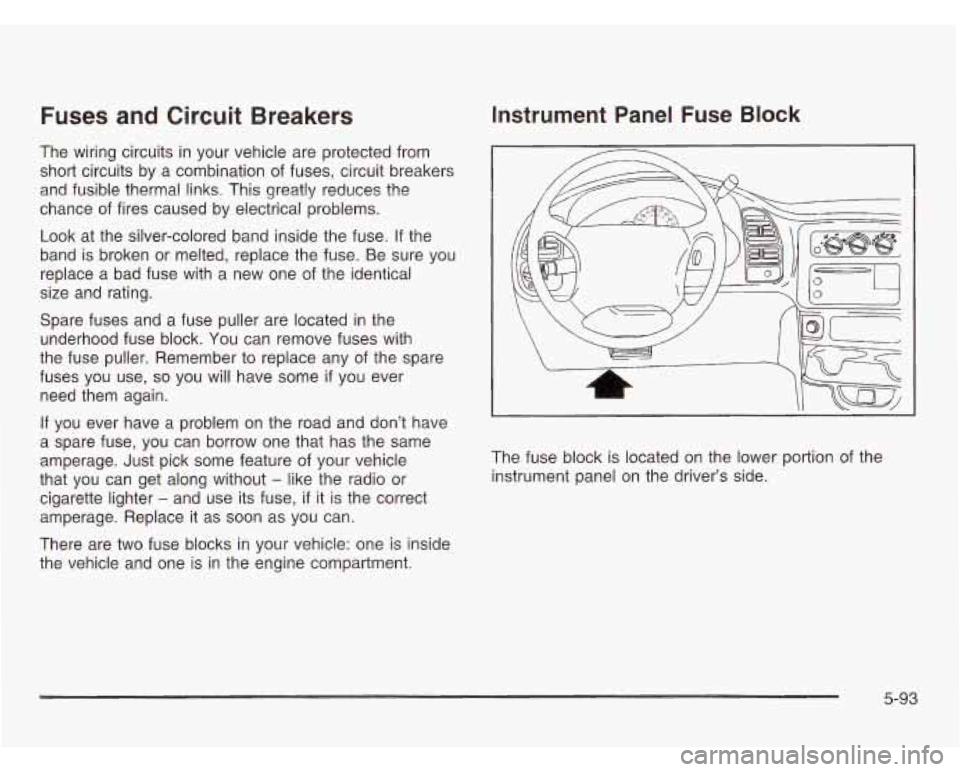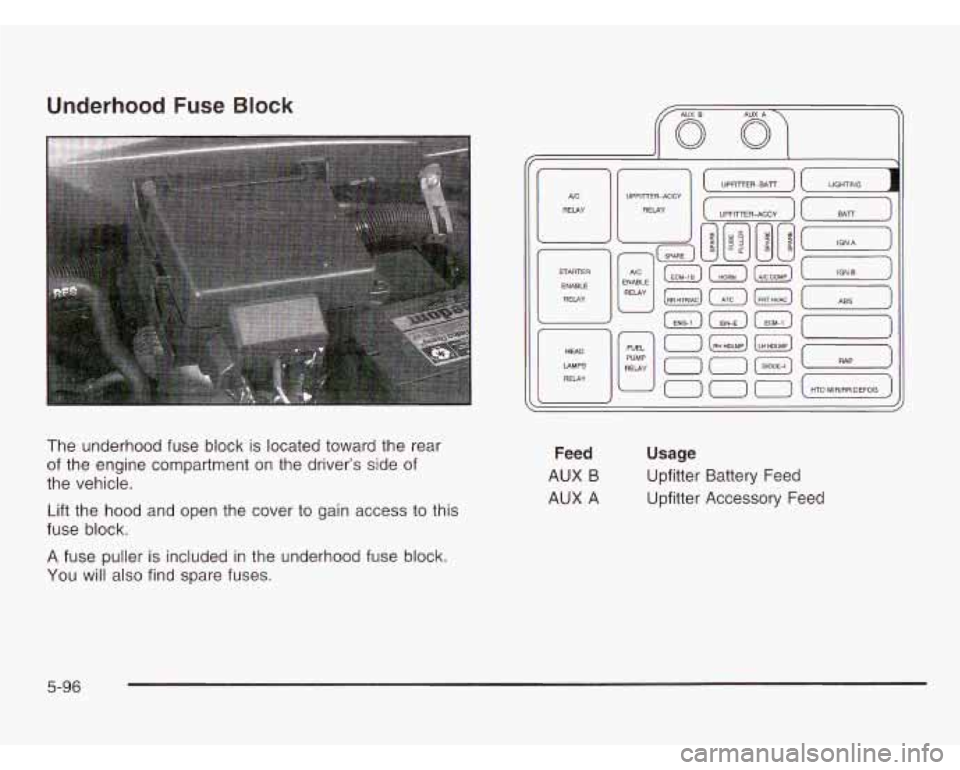2003 CHEVROLET ASTRO fuses
[x] Cancel search: fusesPage 97 of 386

Theft-Deterrent Systems
Vehicle theft is a big business, especially in some cities.
Although your vehicle has a number of theft-deterrent
features, we know that nothing we put on it can make
it impossible to steal. However, there are ways you
can help.
Passlock@
Your vehicle is equipped with the Passlock@
theft-deterrent system.
Passlock@ is a passive theft-deterrent system. Passlock@
enables fuel
if the ignition lock cylinder is turned with
a valid key.
If a correct key is not used or the ignition
lock cylinder is tampered with, fuel is disabled. During normal operation,
the SECURITY light will
go off
approximately five seconds after the key is turned
to RUN.
If the engine stalls and the SECURITY light flashes, wait
until the light stops flashing before trying to restart the
engine. Remember to release the key from START as
soon as the engine starts.
If the engine is running and the SECURITY light comes
on, you will be able to restart the engine
if you turn
the engine
off. However, your Passlock@ system is
not working properly and must be serviced by your
dealer. Your vehicle is not protected by Passlock@ at this
time. You may also want to check the fuse.
See
Fuses and Circuit Breakers on page 5-93.
See your dealer for service.
2-1 8
Page 132 of 386

If a bulb is burned out, replace it to help avoid an
accident.
If the arrows don’t go on at all when you signal
a turn, check for burned-out bulbs and a blown fuse.
See
Fuses and Circuit Breakers on page 5-93.
If you have a trailer towing option with added wiring
for the trailer lamps, a different turn signal flasher
is used. With this flasher installed, the signal indicator
will flash even
if a turn signal bulb is burned out.
Check the front and rear turn signal lamps regularly
to make sure they are working.
Turn Signal On Chime
If your turn signal is left on for more than 3/4 of a mile
(1.2 km), a chime will sound at each flash of the
turn signal. To turn
off the chime, move the turn signal
lever to the center position.
Headlamp High/Low-Beam Changer
To change the headlamps from low beam to high or
high to low, pull the multifunction lever all the way
toward you. Then release it.
When the high beams are
on, this indicator light located on the instrument
panel cluster also will
be on.
Flash-to-Pass
This feature lets you use your high-beam headlamps to
signal a driver in front of you that you want to pass.
It works even
if your headlamps are in automatic.
To use it, pull the turn signal lever toward you, but not
so far that you hear a click.
If your headlamps are in automatic or on low beam,
your high-beam headlamps will turn on. They’ll stay
on
as long as you hold the lever toward you and the
high-beam indicator located on the cluster comes on.
Release the lever to return to normal operation.
3-7
Page 141 of 386

Dome Lamps
The dome lamps will come on when you open a door,
except with the liftgate glass (if equipped).
You can also turn the dome lamps on by turning the
thumbwheel, located next to the exterior lamp control,
all the way up. In this position, the dome lamps will
remain on whether a door is opened or closed.
You can use the
DOME OVERRIDE button, located
near the exterior lamp control, to set the dome lamps
to come on automatically when a door is opened,
or to remain
off. To turn the lamps off, press the button
into the
in position, the dome lamps will remain off
when a door is open. To return the lamps to automatic
operation, press the button again and return it to the
out position. With the button in this position, the dome
lamps will come on when you open a door.
Battery Run-Down Protection
This feature shuts off the dome, courtesy, vanity, reading
and glove box lights
if they are left on for more than
20 minutes when the ignition is off. This will keep your
battery from running down.
If the battery run-down protection shuts off the interior
lamps, it may be necessary to do one of the following to
return to normal operation:
Shut off all lamps and close all doors, or
turn the ignition key to RUN.
Accessory Power Outlets
If your vehicle has this feature, you can plug accessory
electrical equipment into an accessory power outlet.
Just pull on the outlet cover to remove it and follow the
proper installation instructions that are included with
any electrical equipment that you install.
The accessory power outlet is located on the
passenger’s side of the front storage compartment.
These circuits are protected by a fuse and have
maximum current levels.
Certain power accessory plugs may not be compatible
to the power accessory outlet and could result in
blown vehicle or adapter fuses.
If you experience a
problem, see your dealer for additional information on
the power accessory plugs.
Notice: When using an accessory power outlet,
maximum electrical load must not exceed
25 amps.
Always turn
off any electrical equipment when
not in use. Leaving electrical equipment on for
extended periods will drain your battery.
Notice: Power outlets are designed for accessory
plugs only.
Do not hang any type of accessory
or accessory bracket from the plug. Improper use of
the power outlet can cause damage not covered
by your warran-ly.
3-1 6
Page 219 of 386

Section 5 Service and Appearance Care
Appearance Care ............................................ 5.83
Care
of Safety Belts ...................................... 5-86
Weatherstrips
............................................... 5-86
Sheet Metal Damage
..................................... 5-88
Finish Damage
............................................. 5-88
Underbody Maintenance
................................ 5-89
Chemical Paint Spotting
................................. 5-89
GM Vehicle Care/Appearance Materials ........... 5-89
Vehicle Identification ...................................... 5-91
Vehicle Identification Number (VIN)
................. 5-91
Service Parts Identification Label
..................... 5-91
Cleaning the Inside of Your Vehicle ................. 5-83
Cleaning the Outside
of Your Vehicle ................. 5-86
Electrical System ............................................ 5.92
Add-on Electrical Equipment
......................... 5-92
Headlamp Wiring
.......................................... 5-92
Windshield Wiper Fuses
................................ 5-92
Power Windows and Other Power Options
....... 5-92
Fuses and Circuit Breakers
............................ 5-93
Capacities and Specifications ......................... 3-99
Capacities and Specifications
......................... 5-99
Normal Maintenance Replacement Parts ......... 5-101
5-2
Page 309 of 386

Electrical System
Add-on Electrical Equipment
Notice: Don’t add anything electrical to your vehicle
unless you check with your dealer first. Some
electrical equipment can damage your vehicle and
the damage wouldn’t be covered by your warranty.
Some add-on electrical equipment can keep other
components from working
as they should.
Your vehicle has an air bag system. Before attempting to
add anything electrical to your vehicle, see
Servicing
Your Air Bag-Equipped Vehicle on page
1-69.
Headlamp Wiring
The headlamp wiring is protected by a circuit breaker in
the lamp switch. An electrical overload will cause the
lamps to flicker on and
off, or in some cases to remain
off. If this happens, have your headlamp wiring
checked right away.
Windshield Wiper Fuses
The windshield wiper motor is protected by a circuit
breaker and a fuse.
If the motor overheats due to heavy
snow, etc., the wiper will stop until the motor cools.
Although the circuit is protected from electrical overload,
overload due to heavy snow, etc., may cause wiper
linkage damage. Always clear ice and heavy snow
from the windshield before using the windshield wipers.
If the overload
is caused by some electrical problem
and not snow, etc., be sure to get it fixed.
Power Windows and Other
Power Options
Circuit breakers in the fuse panel protect the power
windows and other power accessories. When the
current load is too heavy, the circuit breaker opens and
closes, protecting the circuit until the problem is fixed
or goes away.
5-92
Page 310 of 386

Fuses and Circuit Breakers
The wiring circuits in your vehicle are protected from
short circuits by a combination of fuses, circuit breakers
and fusible thermal links. This greatly reduces the
chance of fires caused by electrical problems.
Look at the silver-colored band inside the fuse.
If the
band is broken or melted, replace the fuse. Be sure you
replace a bad fuse with a new one of the identical
size and rating.
Spare fuses and a fuse puller are located in the
underhood fuse block. You can remove fuses with
the fuse puller. Remember to replace any of the spare
fuses you use,
so you will have some if you ever
need them again.
If you ever have a problem on the road and don’t have
a spare fuse, you can borrow one that has the same
amperage. Just pick some feature of your vehicle
that you can get along without
- like the radio or
cigarette lighter
- and use its fuse, if it is the correct
amperage. Replace it as soon as you can.
There are two fuse blocks in your vehicle: one
is inside
the vehicle and one is in the engine compartment.
Instrument Panel Fuse Block
The fuse block is located on the lower portion of the
instrument panel on the driver’s side.
5-93
Page 313 of 386

Underhood Fuse Block
The underhood fuse block is located toward the rear
of the engine compartment on the driver’s side of
the vehicle.
Lift the hood and open the cover to gain access to this
fuse block.
A fuse puller is included in the underhood fuse block.
You will also find spare fuses.
Feed
AUX B
AUX A
Usage
Upfitter Battery Feed
Upfitter Accessory Feed
5-96
Page 371 of 386

Daytime Running Lamps (DRL) ...................... 3-14
Defensive Driving
............................................. 4-2
Defogging and Defrosting
................................. 3-1 9
Directing the Airflow
........................................ 3-20
Disabling the Theft-Deterrent Feature
................. 3-49
Doing Your Own Service Work
........................... 5-3
Dome Lamps
.......................................... ~ ~~~ 3-16
Door Front Doors
............................................... 2-8
Locks
.......................................................... 2-7
Power Door Locks
......................................... 2-8
Programmable Automatic Door Locks
............... 2-9
Rear Doors
................................................. 2-13
Sliding Side Door
........................................ 2-10
Position, Safety Belt
..................................... 1-1 8
Driver Information System
................................ 2-42
At Night
..................................................... 4-14
City
........................................................... 4-19
Defensive
..................................................... 4-2
Drunken
....................................................... 4-3
Freeway
..................................................... 4-20
Hill and Mountain Roads
.............................. 4-22
In Rain and on Wet Roads ........................... 4-16
Winter
........................................................ 4-24
Driving On Grades
.......................................... 4-39
Driving on Snow or Ice
.................................... 4-24
Driver
Driving Driving
Through Deep Standing Water
............... 4-18
Driving Through Flowing Water
......................... 4-18
Driving with a Trailer
....................................... 4-37
E
Electrical System
Add-on Equipment
...................................... 5-92
Headlamp Wiring
......................................... 5-92
Fuses and
Circuit Breakers
........................... 5-93
Power Windows and Other Power Options
......... 5-92
Windshield Wiper Fuses
............................... 5-92
Emissions Inspection and
Engine Maintenance Programs
................................. 3-33
Air Cleaner/Filter
......................................... 5-24
Battery
....................................................... 5-46
Check and Service Engine Soon Light
............ 3-30
Coolant
...................................................... 5-28
Coolant Heater
............................................ 2-22
Coolant Temperature Gage
........................... 3-30
Cooling System Inspection
............................ 6-30
Cover
........................................................ 5-20
Engine Compartment Overview
...................... 5-14
Exhaust
..................................................... 2-30
Fan Noise
.................................................. 5-39
Oil
............................................................. 5-15
Starting
...................................................... 2-21
Overheating
................................................ 5-31
4